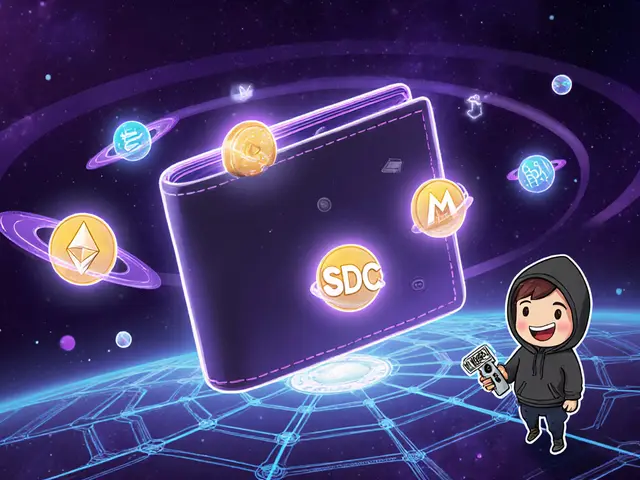Ever wondered how to plug crypto into a traditional contract without the legal headache? In 2025 the regulatory landscape has finally given enough clues to draft solid agreements that involve digital assets. This guide walks you through the essentials - from classifying the token you’re dealing with to writing enforceable clauses, and it even hands you a ready‑made checklist.
Why the Classification Matters
Cryptocurrency is a digital asset that uses cryptographic techniques to secure transactions and control the creation of new units. The U.S. Congress answered years of uncertainty with the CLARITY Act, which splits crypto into three buckets:
- Digital commodities - assets that run on a blockchain but are not securities or stablecoins.
- Investment contract assets - tokens initially sold as securities that become digital commodities after resale.
- Permitted payment stablecoins - regulated like fiat‑backed money under the GENIUS Act.
The bucket determines which regulator watches over you. The SEC (Securities and Exchange Commission) polices investment contracts, while the CFTC (Commodity Futures Trading Commission) handles digital commodities and anti‑fraud enforcement.
Key Entities You’ll Encounter
Getting the terminology right saves you from costly re‑drafts. Below are the eight entities that shape any crypto‑centric agreement today:
- Cryptocurrency - the broad class of blockchain‑based tokens.
- CLARITY Act - the statutory framework that classifies tokens.
- SEC - regulator for securities‑type tokens.
- CFTC - regulator for commodities‑type tokens.
- Digital commodities - non‑security blockchain assets.
- Investment contract assets - tokens that start as securities.
- Stablecoins - fiat‑backed tokens governed by banking regulators.
- Smart contracts - self‑executing code that can replace traditional clauses for certain payments.
Drafting Crypto‑Specific Clauses
Below are the building blocks you should copy‑paste (and tweak) for any agreement that mentions crypto.
- Asset Definition Clause: Clearly state which bucket the token belongs to, referencing the CLARITY Act.
"For purposes of this Agreement, Token X is classified as a digital commodity under the CLARITY Act (2025), §2.1, and therefore falls under CFTC jurisdiction."
- Regulatory Compliance Clause: Tie the parties’ obligations to the relevant regulator.
"Both Parties shall comply with all applicable SEC or CFTC rules, including anti‑fraud provisions, in connection with any transfer of Token X."
- Valuation & Pricing Clause: Use an agreed‑upon oracle or market index to avoid disputes.
"Token X's fair market value shall be determined by the average price reported on CoinGecko over the 24‑hour period preceding the payment date."
- Transfer Mechanics Clause: Define wallet addresses, multi‑sig requirements, and gas fee responsibilities.
"Payment shall be made to the Ethereum address 0xABC…123. The sender bears all transaction (gas) fees unless otherwise agreed."
- Force‑Majeure / Chain‑Split Clause: Account for network outages or hard forks.
"If a blockchain hard fork occurs that materially alters the functionality of Token X, the Parties shall negotiate in good faith to amend the payment terms within 30 days."
- AML/KYC Clause: Reference FinCEN rules and state‑level licensing (e.g., BitLicense in NY).
"Each Party represents that it is a registered Money Services Business under FinCEN and will maintain a contemporaneous AML program as required by 31 C.F.R. §1010.310."
- Smart Contract Integration Clause: When using code to automate performance.
"The Parties agree that the attached Solidity smart contract (Exhibit A) will automatically release Token X upon receipt of the invoice checksum, subject to the escrow conditions set forth herein."

Comparison of Asset Classes
| Attribute | Digital Commodities | Investment Contract Assets | Stablecoins |
|---|---|---|---|
| Regulator | CFTC (commodity jurisdiction) | SEC (securities jurisdiction) | Banking regulators under GENIUS Act |
| Typical Use | Utility tokens, governance tokens | Security tokens, tokenized equity | Payments, remittances, stable-value store |
| Registration Requirement | Intermediaries must register with CFTC | Issuer must register or qualify for exemption under SEC | Issuer must obtain a banking charter or equivalent |
| Anti‑Fraud Enforcement | CFTC has exclusive authority | SEC retains authority over platforms offering the token | Consumer‑protection agencies plus banking supervisors |
| Post‑sale Treatment | Remains a digital commodity in secondary markets | Reverts to digital commodity after resale (per CLARITY) | Maintains 1:1 peg; subject to reserve audits |
Step‑by‑Step Checklist for a Crypto‑Enabled Contract
- Identify the token type (digital commodity, investment contract asset, stablecoin).
- Reference the CLARITY Act clause that classifies the token.
- Determine the governing regulator (SEC or CFTC) and cite the relevant statutory provision. \n
- Choose a reliable price oracle; embed the source in the contract.
- Specify wallet addresses, multisig, and who pays gas fees.
- Include AML/KYC representations consistent with FinCEN guidance.
- Draft a force‑majeure clause covering blockchain disruptions.
- If using a smart contract, attach the code as an exhibit and describe trigger conditions.
- Run a compliance check with your legal counsel-particularly for cross‑border transactions.
- Obtain any required licenses (e.g., BitLicense for NY‑based parties).

Common Pitfalls and How to Avoid Them
Pitfall 1: Ignoring classification. Treating a security token as a commodity can expose you to SEC enforcement. Always start with the CLARITY Act definition.
Pitfall 2: Relying on a single price feed. Oracles can be manipulated. Use at least two independent feeds or a weighted average.
Pitfall 3: Forgetting gas fees. Missing a gas‑fee clause leads to disputes when market congestion spikes. Assign responsibility clearly.
Pitfall 4: Overlooking state licenses. New York’s BitLicense, for example, adds a heavy compliance burden. Check state‑level rules before signing.
Pitfall 5: Assuming smart contracts replace all legal language. Code can automate payment, but you still need fallback provisions for bugs or network failures.
Future Outlook: What to Watch in 2026
Both the SEC and CFTC announced a joint “innovation safe harbor” plan in late 2025. If adopted, it could give DeFi protocols a clearer path to enforceable agreements. Keep an eye on the pending amendments to the Investment Advisers Act, which may require custodians of crypto assets to hold additional insurance. Until those rules settle, the safest bet is to keep contracts grounded in traditional legal language while layering precise crypto clauses.
Frequently Asked Questions
Can I use any cryptocurrency in a contract, or only those listed by the SEC?
You can use any token, but the legal treatment changes based on its classification under the CLARITY Act. Security‑type tokens trigger SEC obligations, while digital commodities fall under CFTC oversight. Ignoring the classification can lead to enforcement actions.
Do I need a BitLicense to accept crypto payments in New York?
If you are a business that receives, transmits, or stores virtual currency for others in New York, a BitLicense is required. The license brings capital, AML, and consumer‑protection requirements that must be reflected in your contracts.
How do I handle a blockchain hard fork that affects the token I’m using?
Include a “hard‑fork” clause that forces the parties to renegotiate payment terms within a set period (e.g., 30 days). This protects both sides from unexpected changes in token value or functionality.
Is it safe to rely solely on a smart contract for payment execution?
Smart contracts automate execution, but they can contain bugs or be vulnerable to attacks. Always retain a fallback clause that allows manual settlement if the code fails or the network is congested.
What AML/KYC steps should I embed in a crypto contract?
Reference FinCEN’s BSA obligations: parties must verify identities, retain transaction records for at least five years, and file SARs for suspicious activity. Including these representations makes the contract compliant with U.S. anti‑money‑laundering law.




24 Comments
Kyla MacLaren
Thanks for the checklist, super helpful!
John Beaver
First, pick a reliable price oracle; many contracts stumble because they rely on a single feed.
Second, spell out who covers the gas fees-ambiguity there leads to disputes during network congestion.
Third, make the token definition explicit, referencing the CLARITY Act section to lock in the classification.
Fourth, embed AML/KYC representations so the agreement satisfies FinCEN rules.
Finally, add a hard‑fork clause so both parties know how to renegotiate if the blockchain splits.
Jennifer Bursey
When you draft the asset definition clause, dropping the exact statutory citation saves the reviewer a lot of time.
The regulator‑specific compliance paragraph should cite both the SEC and CFTC rule numbers, because a downstream auditor will flag any vague reference.
Don’t forget to add a fallback pricing mechanism-using a weighted average of CoinGecko and CoinMarketCap can mitigate oracle manipulation risk.
For gas‑fee allocation, I like the “sender bears all fees unless a surge fee clause is triggered” wording; it’s both clear and flexible.
The AML/KYC representation should mirror FinCEN’s BSA requirements, including a five‑year retention schedule for transaction logs.
In the force‑majeure section, reference both hard forks and network congestion thresholds measured in seconds of latency.
Lastly, attach the smart‑contract code as Exhibit A and add a clause that any bug discovered within thirty days can be patched by mutual consent.
This layered approach makes the agreement enforceable while keeping the legal prose readable.
Maureen Ruiz-Sundstrom
Oh great, another guide that pretends law is simple.
Just follow it and watch the regulators come knocking.
Kevin Duffy
Love the enthusiasm! 😄 Keep it up, the community thrives on optimism.
Tayla Williams
Whilst the exposition is exhaustive, one must contemplate the ethical ramifications of commodifying digital assets; the moral calculus remains unsettled.
Brian Elliot
For newcomers, I recommend starting with the checklist’s first three items before diving into the intricate regulatory citations.
Understanding the token’s bucket clarifies which regulator you’ll be answering to, which in turn guides your compliance roadmap.
Don’t overlook state‑level licensing; many overlook New York’s BitLicense and end up paying hefty penalties.
If you’re building a multi‑jurisdictional deal, map each jurisdiction’s stance on stablecoins early on.
Finally, always have a lawyer experienced in crypto review the final draft; generic templates can miss hidden pitfalls.
Marques Validus
Yo, this guide is fire!!
Crypto contracts used to be a nightmare but now it’s like stacking Lego blocks.
The CLARITY Act really turned the game on its head, no more guesswork.
Don’t forget the gas‑fee clause – otherwise you’ll be stuck paying for spikes like crazy.
And seriously, the hard‑fork clause is a lifesaver when the network decides to go wild.
All in all, this is the blueprint we needed.
Mitch Graci
Wow!!!! That’s some over‑the‑top enthusiasm!!!!
Just make sure you don’t forget the boring legal stuff!!!!
Jazmin Duthie
Nice rundown, though I’m still skeptical about the “smart‑contract replaces all legal language” claim.
Looks shiny but reality bites.
Michael Grima
Legalese overload; keep it simple.
Michael Bagryantsev
Simple is good, but we can’t cut corners where regulators are watching.
Clauses like AML/KYC and force‑majeure are non‑negotiable for compliance.
Maria Rita
Alright team, here’s the play‑by‑play.
First, identify the token’s bucket – that’s your foundation.
Second, write a crystal‑clear definition clause with the CLARITY Act reference.
Third, lock in the price oracle and gas‑fee responsibilities.
Finally, add the hard‑fork fallback and you’re golden.
Jordann Vierii
Energy check! 🎉 When you embed a smart contract, make sure the code is audited by a reputable firm.
Also, keep a manual override mechanism – you never know when a network glitch will strike.
Don’t forget to state who bears the audit costs; otherwise you’ll argue later.
And always test the escrow logic in a sandbox before production.
This way the contract stays both cutting‑edge and safe.
Lesley DeBow
The guide covers the bases, but I’d add a clause about data‑privacy compliance under GDPR when personal data is stored on‑chain.
Even if the token isn’t personal data, the wallet addresses can be tied back to individuals.
Include a statement that both parties will mask any identifying information where possible.
DeAnna Greenhaw
It is incumbent upon the diligent practitioner to scrutinize the semantic architecture of each provision, lest the ostensibly innocuous phrasing precipitate unintended juridical consequences.
Moreover, the interplay between federal statutes and nascent regulatory frameworks warrants meticulous citation to preempt enforcement ambiguities.
One must also contemplate the doctrinal implications of assigning jurisdictional primacy to either the SEC or the CFTC.
Equally vital is the incorporation of a stipulated remedial mechanism in the event of blockchain bifurcation.
Such a comprehensive approach not only fortifies the contractual edifice but also signals professional acumen to counterparties.
In summation, a judicious blend of precision and foresight distinguishes the exemplary contract from the merely functional.
Hari Chamlagai
The CLARITY Act has indeed clarified the tax treatment of many tokens, but the interplay with state‑level securities law remains a gray area.
Practitioners should therefore include a choice‑of‑law clause that points to the most favorable jurisdiction.
Additionally, a representation that the token is not a security at the time of execution can shield parties from retroactive reclassification.
Finally, keep an eye on upcoming amendments; the regulatory landscape evolves rapidly.
Ben Johnson
Interesting take, though I think the guide understates the risk of oracle manipulation.
Multiple data feeds are essential, not optional.
Otherwise you’re handing the counterparty a weapon.
Jason Clark
Let’s walk through a realistic scenario to illustrate why each clause matters.
Suppose Company A wants to pay Vendor B 10,000 TOKEN‑X for software services.
First, the agreement must classify TOKEN‑X under the CLARITY Act; if it’s a digital commodity, the CFTC governs, but if later re‑classified as a security, the SEC steps in.
Second, the price clause references the average of CoinGecko and CoinMarketCap over the prior 24 hours, protecting both parties from price spikes.
Third, the transfer mechanics stipulate that the payment address is 0xABC…123 and that Company A bears all gas fees, eliminating disputes when the network is congested.
Fourth, an AML/KYC representation ensures both entities are registered Money Services Businesses under FinCEN, satisfying federal anti‑money‑laundering statutes.
Fifth, the force‑majeure clause explicitly covers hard forks; if a fork occurs that changes TOKEN‑X’s functionality, the parties have thirty days to renegotiate the payment terms.
Sixth, a smart‑contract attachment automates the release of TOKEN‑X upon receipt of a signed invoice checksum, but a fallback clause states that if the contract fails to execute within 48 hours, manual settlement via traditional wire is permitted.
Seventh, the jurisdiction clause opts for New York law, providing predictability given the state’s robust BitLicense framework.
Eighth, a data‑privacy addendum acknowledges that wallet addresses may be personal data under GDPR and requires prompt redaction upon request.
Ninth, a termination clause allows either party to exit if regulatory guidance changes materially within twelve months.
Tenth, the agreement includes an audit clause granting each party the right to inspect the other’s compliance records annually.
Eleventh, an indemnity provision protects each side from third‑party claims arising from token misrepresentation.
Twelfth, a confidentiality clause preserves the proprietary nature of the software services being rendered.
Thirteenth, a dispute‑resolution clause mandates mediation before arbitration, reducing litigation costs.
Fourteenth, the agreement explicitly states that any amendment must be in writing and signed by both parties, preventing informal email modifications.
Finally, a signature block with digital signatures complies with the ESIGN Act, rendering the contract enforceable in court.
By layering these provisions, the contract not only survives regulatory scrutiny but also provides clear operational guidance, mitigating the most common pitfalls that have plagued crypto‑centric agreements in the past.
Jim Greene
Great deep dive! 😎 This level of detail really helps demystify the process and gives us a solid template to work from.
Luke L
The template is solid, but remember that over‑engineering can scare off smaller partners.
Keep the core clauses and tailor the extras to the risk profile.
Cynthia Chiang
I appreciate the thoroughness of the guide.
One practical tip is to store the agreed‑upon price feeds in an immutable off‑chain repository for audit purposes.
This adds another layer of transparency if a dispute arises.
Also, consider a clause that obliges both parties to notify each other within 48 hours of any regulatory change that could affect the token’s status.
These small additions can save a lot of headaches later.
Hari Chamlagai
Licensing is another hurdle – if either party operates in New York, a BitLicense is non‑negotiable.
Failing to secure it can invalidate the entire payment mechanism.
Include a certification clause that each party holds all required state licenses before execution.
This proactive step keeps the contract airtight.
Ben Johnson
License compliance is a pain, but it’s the price of legitimacy in the crypto world.
Skipping it only invites regulatory backlash.